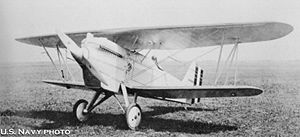- Curtiss F6C Hawk
-
For the Honda motorcycle called F6C in Europe, see Honda Valkyrie.
F6C Hawk Curtiss F6C-1 - Model 34 Role Carrierborne Fighter & Land-based Fighter Manufacturer Curtiss Aeroplane and Motor Company Introduction 1925 Primary users United States Navy
United States Marine CorpsProduced 1927 Number built 75 The Curtiss F6C Hawk was a late 1920s American naval biplane fighter aircraft. It was part of the long line of Curtiss Hawk airplanes built by the Curtiss Aeroplane and Motor Company for the American military.
Originally designed for land-based use, the Model 34C was virtually identical to the P-1 Hawk in United States Army Air Corps service. The United States Navy ordered nine, but as the sixth example was built it was strengthened for carrier-borne operations and redesignated as the Model 34D. Flown from the carriers Langley and Lexington from 1927-1930, most of the later variants passed to Marine fighter-bomber units, while a few were flown for a time as twin-float seaplanes.
Contents
Operators
 United States - Five Model 34C, F6C-1 and XF6C-4 to Marine squadron VF-9M.
United States - Five Model 34C, F6C-1 and XF6C-4 to Marine squadron VF-9M. United States - Four Model 34D, F6C-2 to the U.S. Navy's VF-2 squadron aboard the aircraft carrier Langley.
United States - Four Model 34D, F6C-2 to the U.S. Navy's VF-2 squadron aboard the aircraft carrier Langley. United States - Thirty-Five Model 34E, F6C-3 to the U.S. Navy's VF-5S squadron, later renamed VF-1B on the aircraft carrier Lexington and to Marine squadron VF-8M.
United States - Thirty-Five Model 34E, F6C-3 to the U.S. Navy's VF-5S squadron, later renamed VF-1B on the aircraft carrier Lexington and to Marine squadron VF-8M. United States - Thirty-One Model 34H, F6C-4 to the U.S. Navy VF-2B squadron on the aircraft carrier Langley.
United States - Thirty-One Model 34H, F6C-4 to the U.S. Navy VF-2B squadron on the aircraft carrier Langley.
Variants
- F6C-1 Model 34C virtually identical to the P-1 series.
- F6C-2 Model 34D strengthened for carrierborne operations and fitted with arrester hooks.
- F6C-3 Model 34E modified version of the F6C-2.
- XF6C-4 Model 34H prototype F6C-1 with a Pratt & Whitney R-1340 Wasp radial engine.
- F6C-4 Model 34H production version of the XF6C-4
- XF6C-5 Model 34H prototype F6C-1 with a Pratt & Whitney R-1690 Hornet radial of 525 hp (391 kW).
- F6C-6 Model 34E modified for racing, with its radiator located inside the fuselage.
- XF6C-6 Model 34E the F6C-6 which had won the 1930 Curtiss Marine Trophy was converted to parasol-wing monoplane configuration and given wing surface radiators; after achieving the fastest lap in the 1930 Thompson Trophy race the XF6C-C crashed when its pilot was overcome by fumes.
- XF6C-7 Model 34H testbed for an experimental 350 hp (260 kW) Ranger SGV-770C-1 air-cooled inverted Vee engine.
Specifications (F6C-4)
Data from United States Navy Aircraft since 1911[1]
General characteristics
- Crew: 1
- Length: 22 ft 6 in (6.86 m)
- Wingspan: 37 ft 6 in (11.43 m)
- Height: 10 ft 11 in (3.33 m)
- Wing area: 252 ft² (23.42 m²)
- Empty weight: 1,980 lb (900 kg)
- Max takeoff weight: 3,171 lb (1,441 kg)
- Powerplant: 1 × Pratt & Whitney R-1340 Wasp 9-cylinder air-cooled radial engine, 410 hp (306 kW)
Performance
- Maximum speed: 155 mph (134 knots, 250 km/h) at sea level
- Range: 360 mi (313 nmi, 580 km)
- Service ceiling: 22,900 ft (6,980 m)
- Climb to 5,000 ft (1,520 m): 2.5 min
Armament
- Guns: 2 × fixed .30 in (7.62 mm) Browning machine guns in the forward fuselage
See also
- Related development
References
- Eden, Paul and Soph Moeng. The complete Encyclopedia of World Aircraft. London:Amber Books, 2002.
- Swanborough, Gordon and Peter M. Bowers. United States Navy Aircraft since 1911. London:Putnam, Second edition, 1976. ISBN 0-370-10054-9.
USN fighter designations pre-1962 General Aviation
BrewsterBoeing Curtiss Douglas
McDonnellGrumman Eberhart
GoodyearHall
McDonnellBerliner-Joyce
North American AviationLoening
BellGeneral Motors Seversky FN
Lockheed Ryan FR • XF2R
Northrop Vought Lockheed Wright Convair Lists relating to aviation General Aircraft (manufacturers) · Aircraft engines (manufacturers) · Airlines (defunct) · Airports · Civil authorities · Museums · Registration prefixes · Rotorcraft (manufacturers) · TimelineMilitary Accidents/incidents Records Categories:- Single-engine aircraft
- United States fighter aircraft 1920–1929
- Curtiss aircraft
Wikimedia Foundation. 2010.


